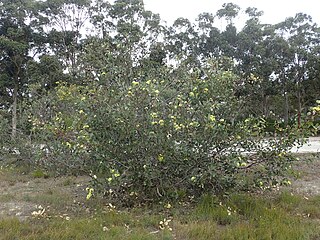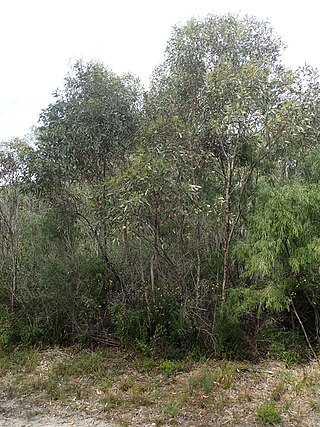
Eucalyptus lansdowneana, commonly known as the crimson mallee or the red-flowered mallee box, is a species of slender stemmed, straggly mallee that is endemic to a restricted area of South Australia. It has rough, fibrous or flaky bark at the base, smooth, grey over creamy-white bark, lance-shaped adult leaves, flower buds in groups of seven, crimson flowers and barrel-shaped fruit.

Eucalyptus goniocalyx, commonly known as long-leaved box, olive-barked box or bundy, is a species of small to medium-sized tree that is endemic to southeastern Australia. It has rough, fibrous or flaky bark, lance-shaped to curved adult leaves, flower buds in groups of seven, white flowers and cup-shaped, cylindrical or barrel-shaped fruit.

Eucalyptus preissiana, commonly known as bell-fruited mallee, is a species of small tree or shrub that occurs in an area between Albany and Esperance in Western Australia. It has a spreading habit, smooth bark, elliptical to egg-shaped or oblong leaves, flower buds in groups of three, yellow flowers and cup-shaped, conical or bell-shaped fruit.

Eucalyptus calcicola, commonly known as the Boranup mallee, Harry Butler's mallee or Hamelin Bay mallee, is a mallee that is endemic to a small area in the south-west of Western Australia. It has smooth, pale greenish bark, lance-shaped to curved adult leaves, flower buds in groups of seven or nine, white flowers and ribbed, cup-shaped to hemispherical fruit.

Eucalyptus calycogona, commonly known as the gooseberry mallee or square fruited mallee, is a mallee that is endemic to southern Australia. It has smooth bark, narrow lance-shaped adult leaves, flower buds that are square in cross-section arranged in groups of seven in leaf axils, creamy white, sometimes pink flowers, and fruit that are square in cross-section.

Eucalyptus capillosa, commonly known as wheatbelt wandoo, or mallee wandoo, is a species of tree or mallee that is endemic to Western Australia. It has smooth, grey bark, lance-shaped to elliptic adult leaves, spindle-shaped flower buds in groups of nine to thirteen, white flowers and barrel-shaped to cylindrical fruit.

Eucalyptus effusa, commonly known as rough-barked gimlet, is a species of mallee or small tree that is endemic to Western Australia. It has thin, rough bark on the base of the trunk, smooth bark above, linear to narrow lance-shaped adult leaves, flower buds arranged in groups of seven, white flowers and cup-shaped to conical fruit.

Eucalyptus eremicola, commonly known as Vokes Hill mallee, is a species of mallee that is native to South Australia and Western Australia. It has rough bark near the base, smooth bark above, linear to lance-shaped adult leaves, flower buds in groups of between nine and fifteen, white flowers and shortened spherical fruit.

Eucalyptus gittinsii, commonly known as northern sandplain mallee, is a species of mallee that is endemic to Western Australia. It has smooth greyish bark, sometimes with rough flaky bark near the base, lance-shaped to curved adult leaves, flower buds in groups of three, whitish flowers and cylindrical to barrel-shaped fruit.

Eucalyptus goniantha, commonly known as Jerdacuttup mallee, is a species of mallee, or rarely a tree, that is endemic to Western Australia. It has smooth bark, lance-shaped adult leaves, flower buds in groups of between seven and eleven, creamy white flowers and more or less ribbed, hemispherical fruit.

Eucalyptus insularis, commonly known as Twin Peak Island mallee, or North Twin Peak Island mallee, is a species of mallee that is endemic to a small area of southern Western Australia. It has mostly smooth bark, dull green, linear adult leaves, flower buds in group of between nine and twenty or more, white flowers and barrel-shaped fruit.

Eucalyptus kessellii, commonly known as Jerdacuttup mallee, is a species of mallee that is endemic to an area along the south coast of Western Australia. It has very hard, rough bark on the trunk of larger specimens, smooth greyish and brownish bark above, lance-shaped to egg-shaped adult leaves, flower buds in groups of three or seven, creamy white flowers and downturned, conical to cup-shaped fruit.

Eucalyptus mannensis, commonly known as Mann Range mallee, is a species of mallee that is native to Western Australia, South Australian and the Northern Territory. It has rough bark at the base of the trunk, smooth bark above, narrow lance-shaped adult leaves, flower buds in groups of between seven and eleven, creamy white flowers and hemispherical fruit.

Eucalyptus phenax, commonly known as green dumosa mallee or white mallee, is a species of mallee that is endemic to southern Australia. It has smooth bark, lance-shaped adult leaves, flower buds in groups of seven or nine, white flowers and cup-shaped to cylindrical fruit.

Eucalyptus pluricaulis, commonly known as the purple-leaved mallee, is a species of mallee that is endemic to Western Australia. It has smooth bark, dull bluish green, lance-shaped leaves, flower buds in groups of between nine and fifteen, pale yellow flowers and cylindrical to barrel-shaped fruit.

Eucalyptus conglobata, also known as the cong mallee or Port Lincoln mallee, is a species of eucalypt that is native to the south coast of Western Australia and South Australia. It is a mallee with smooth bark, lance-shaped adult leaves, flower buds in groups of seven, white flowers and clustered hemispherical fruit.

Eucalyptus canescens, commonly known as the Ooldea Range mallee or Beadell's mallee, depending on subspecies, is a species of mallee that is endemic to southern Australia. It has rough bark from the base of the trunk to the thicker branches, smooth bark on the thin branches, egg-shaped to lance-shaped adult leaves, flower buds in groups of between seven and eleven, creamy white flowers and smooth cup-shaped to conical, and sometimes ribbed fruit.
Eucalyptus distuberosa is a species of mallet that is endemic to the south-west of Western Australia. It has smooth dark grey to tan-coloured or creamy white bark, glossy dark green, lance-shaped adult leaves, flower buds in groups of seven, white flowers and cup-shaped to conical fruit.
Eucalyptus pauciflora subsp. parvifructa is a mallee or small tree that is endemic to a small area of Victoria, Australia. It has smooth bark, slightly glaucous branchlets, glossy green, lance-shaped adult leaves, flower buds usually in groups of seven, white flowers and hemispherical or cup-shaped fruit. It differs from other subspecies of E. pauciflora in having a smaller habit and smaller leaves, flower buds and fruit.

Eucalyptus socialis subsp. eucentrica, commonly known as the inland red mallee, is a subspecies of mallee that is endemic to inland Australia. It usually has rough bark on the base of the trunk, smooth bark above, lance-shaped adult leaves, flower buds in groups of between seven and eleven, pale creamy yellow flowers and barrel-shaped to urn-shaped or spherical fruit.
























